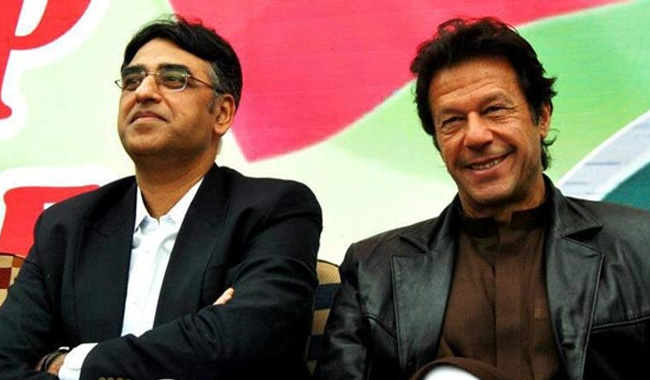An accounting problem?
Take a long, hard look at the difference in how much power India enjoys on the world stage, and how little Pakistan does. It begins in 1991.
Take a long, hard look at the difference in how much power India enjoys on the world stage, and how little Pakistan does. It begins in 1991.
By 1991, decades of India’s infamous ‘Hindu rate of growth’ had choked the economy to the limit. Its total foreign exchange reserves dwindled to the point that it had less than a month’s worth of dollars to pay for imports. The IMF forced India to sign over 67 tonnes of its gold reserves as collateral for a $2.2 billion loan, and a government fell. The new government came and appointed Dr Manmohan Singh as finance minister to oversee transformational reforms. India has never gone back to the IMF. In 2009, less than two decades later, India purchased over 200 tonnes of gold from the IMF.
It is increasingly clear that Pakistan’s stability (and, by extension, its national security), as well as the ambitions of the PTI are both subservient to a looming macroeconomic crisis. It is cruel enough that an incoming government has to deal with this kind of crisis at the very dawn of its first opportunity to deliver on a mandate that, despite some blemishes, seeks comprehensive change and reform. What makes it worse is that this isn’t a first. The debate that we are having now has been had in 2008, and in 2013. How does Pakistan keep ending up at the same economic stop despite traversing long distances in the spaces between?
First, some acknowledgement of the distance travelled. In 2007, the total size of Pakistan’s economy (its GDP) was just over $150 billion. In 2017, it was nearly $305 billion. Pakistan’s economy has more than doubled in the last decade. A decade ago, Al-Qaeda and the TTP were leading a cocktail of Pakistan’s enemies (including many within our borders) in an orgy of murder that lasted over six years, and only began to subside in 2015.
It seems longer ago than it really was that innocent citizens, policemen and soldiers were being killed on a daily basis. Today, even Pakistan’s enemies marvel at the capacity of this country’s people to hold their nerve, stand by their soldiers and their politicians, withstand attempts to rip them apart, and find and destroy the enemy from the alleyways of our cities to the caves in our mountains.
Along the way, we have picked up a lot of injuries – in the tribal areas, in Balochistan, in Karachi and in how key national institutions engage with each other. Every Pakistani victory has come at a cost. But a nation that can win hard wars, can also win tricky battles. All it requires is some deeper than usual thinking about how the injuries were inflicted, and what it will take to repair the damage.
In ‘Why Growth Matters’, Arvind Panagariya and Jagdish Bhagwati beautifully lay out the Track-I and Track-II trajectory of reforms that India is on to continue to grow for a generation. The pathways of India are exclusive to India, and on the back of Pakistan’s savings rate differential alone, the Indian growth formula is not possible for Pakistan to mimic.
But the one lesson that Pakistan can draw from India is that dealing with an economic crisis cannot be based on an exercise free of strategy, with only the short-term goal of staving off bankruptcy. Unfortunately, even today, the discussion of Pakistan’s economy is an accounting exercise. We face a macroeconomic crisis because we don’t have enough dollars to pay for things that demand payment in dollars (like machinery that we need to build vital national infrastructure, and oil and gas that help fuel our cars and homes to chug along on this new infrastructure). The accounting response is either to say that “we need to cut down on the things that cost us dollars” or to say that “we need to bring in more dollars”.
We can do so from the income or revenue side. But it is useful to remember that the country’s exports fell by over $3 billion between 2013 and 2017. Rebuilding the exportability of Pakistani products will take longer than Asad Umar, Jahangir Tareen and Imran Khan have in the immediate short run.
Moreover, this approach to the economy is mined with risks that will ensure a repetition of our old cycle of borrowing-spending-running out of money-borrowing again. For accountants, the problem in this cycle is either borrowing, or spending, or running out of money. The problem in this cycle is actually what is not part of the cycle: the fruits of spending.
In a country with over 100 million young people, all of whom need jobs and deserve a better life than their parents had, can we afford to stop spending? Stop building high schools for girls? Stop buying nutrition kits for babies in Thar Desert and the Karakoram mountains? Stop building infrastructure and stop consuming fuel? Stop funding the BISP? Not really. In fact, on every one of these fronts, Pakistan needs to spend more, not less.
Small quanta of expenditures like the cost of the cutlery at the PM House or what is served at state dinners is not a serious area of expenditure. It is noble to seek to rationalise and reduce lavish spending by our rulers, but it is not a serious part of economic decision-making. Austerity is about cutting spending in big-ticket areas.
In Pakistan, austerity basically means only one thing: cutting the Public Sector Development Programme (and the annual development plans of the provinces). In the 2017-18 annual budget, the total value of only CPEC-related PSDP spending is over Rs187 billion, the vast majority of which is highways. There is non-CPEC spending in the PSDP too.
But the question that we must ponder while considering or tightening Pakistan’s belt is what it would do to the country. The short answer? It would kill growth. In ‘The Growth Delusion’, David Pilling argues that growth is the wrong goal. He may be right as far as over-the-hill economies in the West are concerned, but Pakistan is among the youngest countries on the planet and has never grown at the same rate as India or China. We can eschew growth after we have grown and exhausted our potential for growth, not before.
The knock-on effects of lower public sector spending are suicidal on their own. To lower it in areas like infrastructure is doubly dangerous. But to lower it on the infrastructure that Pakistan has agreed to build in partnership with China is the triple threat. Pakistan’s only reliable strategic partner should never be left wondering what we are doing. The bottom line? We cannot treat Pakistan’s economic crisis like an accounting problem.
Stephanie Kelton, the most important voice among proponents of the Modern Monetary Theory (MMT), argues that when a “government tightens its belt, it lightens its (own) load… shifting the relative burden onto (ordinary people)”. Her solution is mission-oriented budgeting: which ignores the balance between expenditure and revenue.
Can Pakistan afford such radical thinking? Maybe not. Pakistan’s national sovereignty is already depleted. But what stops the PTI from making the sensible decision to install top-shelf talent in the most important jobs in the country? The options for what Pakistan can do immediately are extremely limited. But options for how economic policy is made from now on are not. Is the PTI in 2018 is just another version of the PPP in 2008 and the PML-N in 2013? Five jobs will tell us the answer: the chairperson of BOI, the chairperson of the SECP, the chairperson of the FBR, the deputy chairperson of the Planning Commission, and the finance secretary.
If all the PTI can manage is another gang of retired old men, or nearing retirement DMG/PAS officers, Pakistan is heading for another turn on its debt merry-go round. We will begin to learn very soon if Imran Khan is serious about his agenda for reform.
The writer is an analyst and commentator.
-
 Princess Beatrice, Eugenie Resort To Begging Sarah Ferguson: 'It'll Bring Disaster For The Whole Family'
Princess Beatrice, Eugenie Resort To Begging Sarah Ferguson: 'It'll Bring Disaster For The Whole Family' -
 Jenny Slate Hails Blake Lively Amid Lawsuit Against Justin Baldoni
Jenny Slate Hails Blake Lively Amid Lawsuit Against Justin Baldoni -
 Sophie Wessex Shares 'frustration' From Early Days In Royal Family
Sophie Wessex Shares 'frustration' From Early Days In Royal Family -
 Jason Momoa's Aquaman Unseen Snap Revealed
Jason Momoa's Aquaman Unseen Snap Revealed -
 Prince Harry Taught Only Way King Charles 'will Take Him Seriously'
Prince Harry Taught Only Way King Charles 'will Take Him Seriously' -
 Meghan Markle’s Reaction To UK Talks With Prince Harry Comes To The Forefront: ‘Leaving Me?’
Meghan Markle’s Reaction To UK Talks With Prince Harry Comes To The Forefront: ‘Leaving Me?’ -
 Taylor Swift Slams Justin Baldoni In Explosive Text Messages, Court Filing Reveals
Taylor Swift Slams Justin Baldoni In Explosive Text Messages, Court Filing Reveals -
 Blake Lively’s Drops New Allegations Against Justin Boldoni About Birth Scene
Blake Lively’s Drops New Allegations Against Justin Boldoni About Birth Scene -
 Andrew's Reasons For Giving Sarah Ferguson A Rent-free Home For 30 Years After Divorce Finally Finds An Answer
Andrew's Reasons For Giving Sarah Ferguson A Rent-free Home For 30 Years After Divorce Finally Finds An Answer -
 Charlie Puth Reveals Wake-up Moment That Made Him Quit Alcohol
Charlie Puth Reveals Wake-up Moment That Made Him Quit Alcohol -
 Meghan Trainor Welcomes Baby Girl Mikey Moon Trainor And Turns Emotional
Meghan Trainor Welcomes Baby Girl Mikey Moon Trainor And Turns Emotional -
 Meghan Markle Would Not 'hide Away' From UK For Harry's Sake
Meghan Markle Would Not 'hide Away' From UK For Harry's Sake -
 Why Keith Urban's Daughters Are Avoiding His Rumored Girlfriend? Source
Why Keith Urban's Daughters Are Avoiding His Rumored Girlfriend? Source -
 Sarah Ferguson Led Andrew To Jeffrey Epstein: ‘She Wanted Him To Ask For More Money’
Sarah Ferguson Led Andrew To Jeffrey Epstein: ‘She Wanted Him To Ask For More Money’ -
 Blake Lively Claimed Justin Baldoni 'made A Monster' Of Her, Court Docs Reveal
Blake Lively Claimed Justin Baldoni 'made A Monster' Of Her, Court Docs Reveal -
 Prince William Accused Of 'harsh Decisions' Over Disgraced Royal
Prince William Accused Of 'harsh Decisions' Over Disgraced Royal




